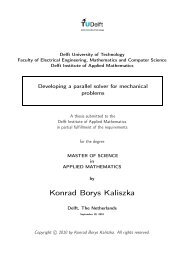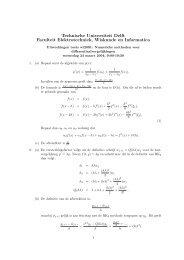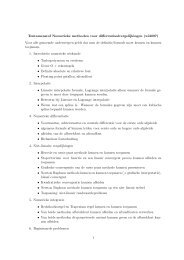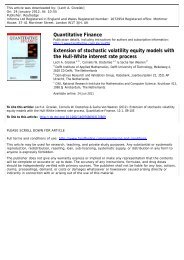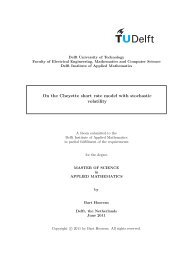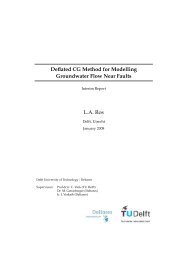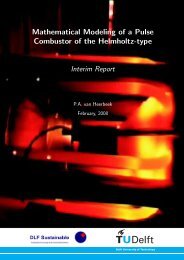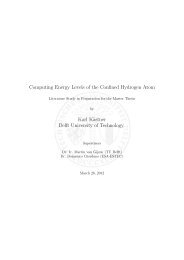AN EVALUATION OF PARALLEL MULTIGRID AS A SOLVER AND A ...
AN EVALUATION OF PARALLEL MULTIGRID AS A SOLVER AND A ...
AN EVALUATION OF PARALLEL MULTIGRID AS A SOLVER AND A ...
Create successful ePaper yourself
Turn your PDF publications into a flip-book with our unique Google optimized e-Paper software.
<strong>MULTIGRID</strong> <strong>AS</strong> A <strong>SOLVER</strong> <strong>AN</strong>D A PRECONDITIONER 101the following results were obtained: on a 129 2 grid, 62 iterations; on a 257 2 grid, 139iterations, on a 513 2 grid, 444 iterations, and on a 514 2 grid, 446 iterations. Thenumber of iterations grows rapidly for larger grid sizes.Problem II: Rotating convection-diffusion equation. The next problem is a rotatingconvection-diffusion problem, presented in [21] and also tested in [23],(46)−ɛ∆φ + a(x, y) ∂φ + b(x, y)∂φ = 1 on Ω = (0, 1) × (0, 1).∂x ∂yHere, a(x, y) = − sin(πx). cos(πy), b(x, y) = sin(πy). cos(πx).Dirichlet boundary conditions are prescribed: φ| Γ = sin(πx) + sin(13πx) +sin(πy) + sin(13πy).A convection dominated test case is chosen: ɛ = 10 −5 . The convection terms arediscretized with a standard upwind discretization, due to the fact that the multigridmethods with the chosen smoothers are not convergent methods for matrices resultingfrom a second-order discretization. In a forthcoming paper, possibly part III, we willconcentrate on second-order accuracy for convection-diffusion problems.Spectrum analysis. For this test problem we investigate the eigenvalue spectrumof the Richardson iteration matrix I − K −1 A (5). For K −1 in (5) all MG methodsare compared on a 33 2 grid. The spectra are presented in Figure 5. As can beseen, most eigenvalues are clustered around zero for MG1 and MG2 but not for MG3.For MG3 this has also been observed in [12]. Furthermore, a difference between thedistribution of MG1 and MG2 can be seen; the spectral radius of MG1 is larger. Theactual convergence with these methods as solvers and preconditioners on the 33 2 gridis presented in Figure 6. Also, if it was obtained, the observed asymptotic convergenceρ is presented. If an asymptotic convergence was not found, the average convergenceρ (n) = (r (n) /r (0) ) 1 n is shown. Comparing Figures 5 and 6 we see that the spectralradius determines the convergence of the MG methods as solvers, as expected.For this problem we study the development of the solutions λ ∗ kof the minimalresidual polynomial p k (λ ∗ k ) = 0 from (16). Solutions 1−λ∗ kof the last five polynomialsuntil convergence are presented in Table 4 for MG1 and MG2. Due to the fact that1 − λ ∗ is presented, it is possible to compare Table 4 and the eigenvalues in Figure 5.It can be clearly seen that the vectors belonging to the most distant eigenvalues ofI − AK −1 from zero are first captured in the Krylov space. The development of thisspace gives a clear view of the search directions of GMRES. For MG1 six eigenvalueswith largest distance from zero are obtained from the ninth polynomial, for MG2 fourare found after seven iterations. So the choice of s k (λ) in (13) may give a nearlyoptimal upper bound.MG as solver and preconditioner. Tables 5, 6, and 7 present convergence resultsobtained on three different grid sizes, 129 2 , 257 2 , and 513 2 . The MG methods areused as solvers in Table 5, as preconditioners for BiCGSTAB in Table 6, and forGMRES(20) in Table 7. For MG3 the number of J 11 steps is as in Problem I, withless steps as a preconditioner than as a solver. Here, matrix-dependent interpolationsin (41) did not result in a robust MG3 method. It can be seen that MG2 handlesthis test case with dominating convection better than the other methods. With theexpensive W-cycle almost grid-independent convergence is found. Very satisfactoryconvergence associated with small elapsed times is found in most cases with the F-cycle. With the V-cycle used as a preconditioner the best elapsed times are found,but the number of iterations is increasing for large grid sizes. Again, the convergenceis fastest when the MG methods are used as preconditioners.




